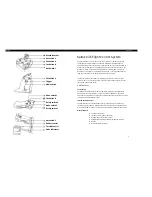
P/N 133487
87
Banner Engineering Corp.
•
Minneapolis, U .S .A .
www .bannerengineering .com • Tel: 763 .544 .3164
SC22-3 Safety Controller
Instruction Manual
Appendix A
A.7 Emergency Stop Push Buttons
The SC22-3 safety inputs may be used to monitor
emergency stop push buttons .
Safety Circuit Integrity Levels
Requirements vary widely for the level of control reliability or
safety category per ISO 13849-1 (EN954-1) in the application
of emergency stops . While Banner Engineering always
recommends the highest level of safety in any application, it
is the responsibility of the user to safely install, operate and
maintain each safety system and comply with all relevant laws
and regulations .
The safety performance (integrity) must reduce the risk
from identified hazards as determined by the machine’s risk
assessment . See Section A .1 for guidance if the requirements as
described by ISO 13849-1 (EN954-1) are to be implemented .
In addition to the requirements stated in this section, the design
and installation of the Emergency Stop device should comply
with ANSI NFPA79 or ISO 13850 .
A.7.1 Emergency Stop Push Button Requirements
As shown in the following figures, the E-stop switch must
provide one or two contacts for safety which are closed when
the switch is armed . Once activated, the E-stop switch must
open all its safety-rated contacts, and must require a deliberate
action (such as twisting, pulling, or unlocking) to return to the
closed-contact, armed position . The switch must be a “positive-
opening” (or direct-opening) type, as described by IEC 60947-
5-1 . A mechanical force applied to such a button (or switch)
is transmitted directly to the contacts, forcing them open . This
ensures that the switch contacts will open whenever the switch
is activated .
• Standards ANSI NFPA 79, IEC/EN 60204-1, and
ISO 13850 specify additional emergency stop switch device
requirements, including the following:
• Emergency stop push buttons shall be located at each
operator control station and at other operating stations where
emergency shutdown is required .
• Stop and Emergency stop push buttons shall be continuously
operable and readily accessible from all control and
operating stations where located . Do not mute or bypass
E-stop buttons.
• Actuators of emergency stop devices shall be colored red .
The background immediately around the device actuator
shall be colored yellow . The actuator of a push-button-
operated device shall be of the palm or mushroom-head
type .
• The Emergency stop actuator shall be a self-latching type .
NOTE: Some applications may have additional requirements .
The user must comply with all relevant regulations .
Safety Circuit Integrity Levels and Multiple E-Stop Buttons
As part of the required risk assessment for the machine,
ANSI NFPA 79 and IEC/EN 60204-1 state that the safety
performance (integrity) must reduce the risk from identified
hazards as determined by the risk assessment . See Section A .1
for guidance if the requirements as described by ISO 13849-1
(EN954-1) are to be implemented .
WARNING . . .
Reset Routine
Required
U .S . and international standards require that a
reset routine be performed after returning the E-stop switch to its
closed-contact position (when arming the E-stop switch) . When
automatic reset is used, an alternate means must be established to
require a reset routine, after the E-stop switch is armed . Allowing
the machine to restart as soon as the E-stop switch is armed
creates an unsafe condition which could result in serious
injury or death.
WARNING . . .
Emergency Stop
Functions
Do not mute or bypass any Emergency Stop
device. ANSI NFPA79 and IEC/EN 60204-1 require that the
Emergency Stop function remain active at all times . Muting or
bypassing the safety outputs will render the emergency stop
function ineffective.
The SC22-3 Emergency Stop configuration prevents muting or
bypassing of the E-Stop input(s). However, the user still must
ensure that the E-Stop device remains active at all times.
















































